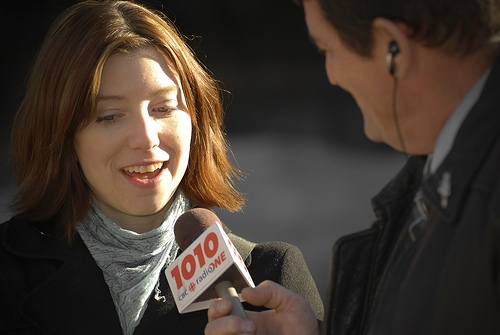
Why do an interview?
- Haven’t got the footage? – If a ship sinks at sea, you can interview the survivors Could be Interesting filler if used sparingly.
- If it’s a significant person, it can add credibility
Planning
- Do your research – have a good idea of questions and background about the subject.
- Consider the finished product.
- Talk to the interviewee beforehand – Ask if they can, to answer in full questions, to aid editing later if you’re going to remove the interviewer.
- Mention that they should avoid fidgeting – it makes them look shifty and untrustworthy – if they can’t stop, film a closer shot of their face, so that it’s not so noticeable
Clothing
- Black is bad – no texture
- Fine repeating patterns or stripes will move and distract on camera – Strobing
Camera Height
- A high camera looks down on the subject, belittling them
- A low camera makes them appear more significant
- Usually – put the camera at eye height
- Get Permission before you start
- Before you start, with the camera running, explain what the interview is for, and get their permission on film – legally acceptable.
- This also allows a chatty period to get the subject used to the camera
- The Interview
If they start to waffle, interrupt with another question, or be prepared to edit lots –
you’ll need plenty of cutaways.
Don’t let them use technical words – maybe ask them “what did that word mean” or
frown and they might notice and explain better
Assume the audience is an intelligent 15 year old – intelligent, but may not have the
same life experience as you.
Listen to what they’re saying – and look for keywords that can be illustrated by
filming cutaways later – if they’re talking about Motorway noise, afterwards, get
some shots of a motorway to illustrate the interview, to make it less boring.
Open Questons
Open Questions and Closed Questions – Start with the six journalistic W’s – Who
When, Where, What, Why, and hoW ☺.
CUT!!
If you have to cut – or the subject fluffs a line, wait for the subject to finish, stop
filming, move the camera to a different position, and ask the question again. It’ll look
fine when you edit it together.
Body Language
interviewee rubbing nose – possibly lying
touching face – Hiding truth
Avoiding eye contact – about to fib – eyes are the gateway to the soul
Shut-UP!
Ask a questions and then shut-up!
Its easy and natural to say mmmhm and “yes, I see” to try to encourage the
interviewee to continue but disembodied sounds will seem weird when you edit…
The Silence
Use silence – just look serious and maintain eye contact – they’ll feel pressure and feel
obliged to answer – not a nice technique, so be careful when you use it
Positioning
If the interviewer is visible and you’re going to use their voice, put them to the left of
the camera, out of shot, and place the subject at the right 3rd or the screen looking into
the empty space on the left, otherwise it’ll look like they’re looking off the screen.
If someone is presenting to the camera, they should be centre screen, unless they’re
illustrating something in the background and it’s important to maintain eye contact
with the camera – the subject will look very shifty if they don’t maintain eye contact.
Background
80% of what a viewer takes from an interview is visual information.